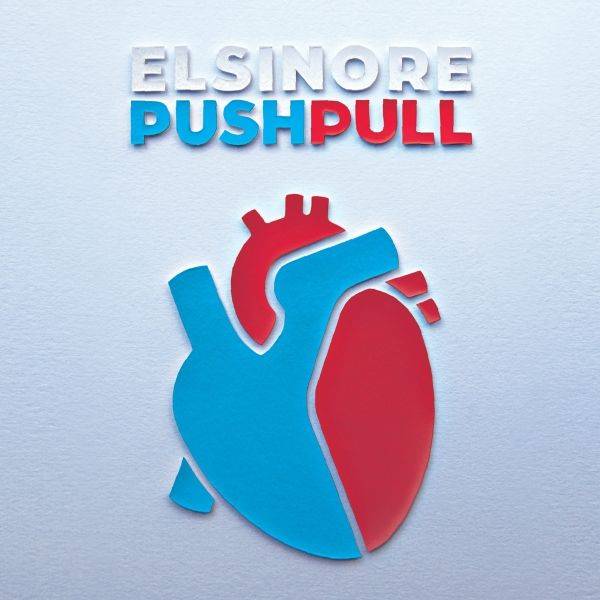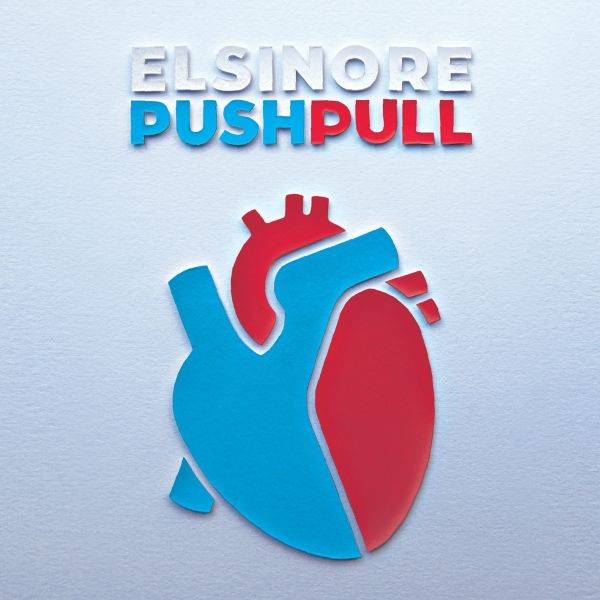
Local heroes Elsinore are currently songwriter/vocalist/guitarist Ryan Groff, keyboardist/vocalist Mark Woolwine, drummer James Treichler, and bassist Brad Threlkeld. Elsinore’s last album, 2010’s Yes Yes Yes, was quite successful. Several of the songs made it onto TV shows and commercials. But then, right before hitting the studio to record their latest album, Push/Pull, drummer Dave Pride and bassist Chris Eitel left the band. So Push/Pull is a kind of test for Elsinore: how well did they bounce back from half their band leaving?
They passed the test.
As a recent transplant to Champaign-Urbana, I thought I’d never heard anything by Elsinore before. But when I started the record and Push/Pull’s first track “The Art of Pulling” began to play, I was all “Hey, I’ve heard this before.” It’s been playing on WPCD and I like it. It’s got enough dynamics and power pop crunch to get my head bobbing and earn a spot on repeat on my playlist. And this holds true for most, if not all, of the up-tempo numbers on the record.
Elsinore’s new rhythm section more than holds its own compared to previous incarnations. Where on Yes Yes Yes the drums were kind of thin and buried in the mix, Push/Pull‘s more rocking tracks put the drums front and center and let Treichler really flex his drumming muscles. The standout track for him “Life Inside an Elephant,” where the expansive drums and Woolwine’s proggy keyboards work together to create an epic number that stands shoulder-to-shoulder with some of our beloved prog-rock forefathers’ best work.
Yes Yes Yes was a nice, breezy pop album, full of happy sunny moments making you glad to be alive. While Push/Pull isn’t darker per se, it has a more inward, quiet feel to it. There are lots of down-tempo numbers where Groff does some real soul searching (a lot of his lyrics are written in the 2nd person, a writing choice that I don’t have a problem with but some people feel tends to obfuscate and confuse, like who the hell is this guy talking to?). Push/Pull has more of a lush, chamber pop feel to it in contrast to Yes Yes Yes‘s bubblegum rock.
Push/Pull presents Elsinore as a band from a different era. This is mainly due to Groff’s voice: he claims inspiration from Thom Yorke, but I say this guy takes a page from acts like Genesis (back when they weren’t lame), Yes, maybe even some late-model Sunny Day Real Estate. His singing is quite beautiful and equally suited for balladry and belting during the foot-stompers, and Push/Pull has both. Woolwine’s keyboard work also helps lend the album an air of sepia-toned rock-and-roll nostalgia, as does Groff’s articulate, literate lyrics.
Push/Pull is most successful when all these elements—proggy keys, thumping drums, indie rock bleeps and bloops, and Groff making the use of his full vocal range singing thought-provoking lyrics—combine, as they do on “Ultraviolence,” a meditation on, well, violence. It starts quieter, then crescendos into a chorus that makes you know none of the band is just phoning it in, and has enough meat and potatoes in the singing and musicianship to make a full meal.
The album tends to flounder a bit on four or five quieter, more contemplative songs. See, while Groff has a beautiful voice, his delivery tends to start sounding the same: either he’s singing two or three words, pausing while holding out the last word, then repeating the process, or he’s holding out every word he sings across several beats. When there are other, more interesting things going on in a song it’s OK, you don’t really notice it, but when the song’s quieter or the instrumentation isn’t as interesting, it really stands out.
Although the album overall successfully mines the past for musical inspiration—there are shades of almost every major rock and soft-rock style here, from vocal jazz of the 40s and 50s to disco to 90s indie/underground—here are also times where Push/Pull flies a little too close to nostalgia’s sun for its own good. “Sinister Sister” is an example of this and probably the weakest track on the album; it’s an exercise in “let’s see how much we can get away with in a genre experiment” (in this case, a weird amalgamation of mid-70s/early-80s soft rock/smooth jazz with crooner vocals) that just left me wondering “why”? Some bands quite successfully pull off this “tightly-crafted-albeit-boring-as-hell music as art because of reasons” thing (think Destroyer’s latest album), but with “Sinister Sister” and tinges of other songs on the album, I just can’t see the reasons to justify the period pieces.
It’s not like all of Push/Pull‘s quiet songs aren’t good. I loved “New England” in its simple, gorgeous, minor-key ruminations that swell and threaten to turn ominous but never quite do. It’s just that at other times, the down-tempo moments are a bit muddled and confused.
Push/Pull represents a sure step forward for Elsinore: they’ve reassembled themselves after near-breakup and proved they’ve still got it. The production on this album, especially when compared to their earlier work, is gorgeous, the songwriting more mature and nuanced, and their playing is tight. As a record, Push/Pull is marked by several tracks serving as a strong skeleton some of the weaker, quieter, more similar-sounding songs have a hard time fleshing out.








